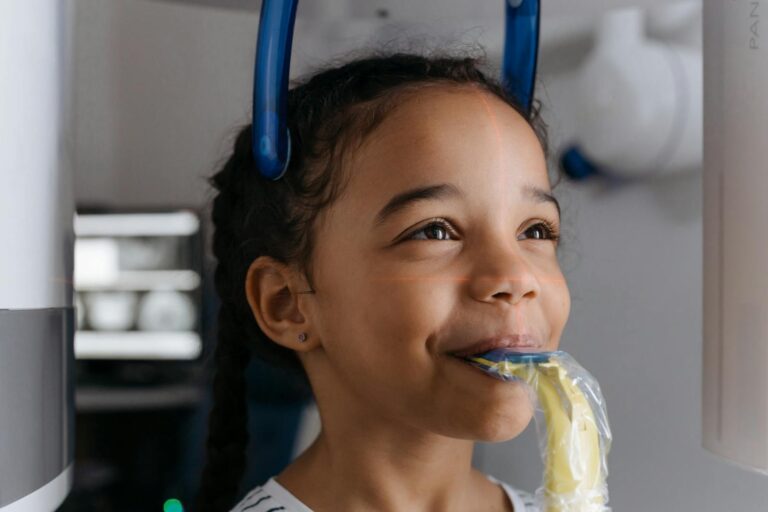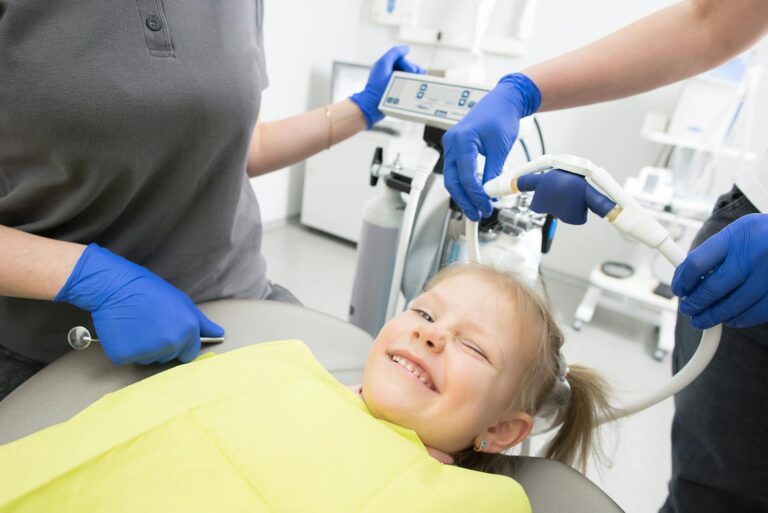Why Does My Child Have Bad Breath Even After Brushing?
As a parent, you’re doing everything right—your child brushes their teeth twice a day, uses a kid-friendly toothpaste, and maybe even rinses with mouthwash. But despite your efforts, there’s still that occasional (or persistent) sour odor when they speak or yawn. If you’ve ever found yourself wondering, “Why does my child still have bad breath even after brushing?”—you’re not alone.
The truth is, bad breath, or halitosis, isn’t always about whether or not a child is brushing their teeth. In fact, there are several other factors that can cause lingering mouth odor, even when oral hygiene routines seem consistent. Let’s take a closer look at some of the most common causes—and what you can do about them.
Poor Brushing Technique or Missed Spots
Even if your child is brushing twice a day like clockwork, that doesn’t always mean their mouth is getting thoroughly cleaned. Many young children—especially those under the age of 7—simply don’t yet have the fine motor skills, focus, or understanding needed to brush properly. As a result, certain areas in the mouth are frequently missed, and those overlooked spots can quickly become breeding grounds for odor-causing bacteria.
Commonly missed areas include:
- The gum line: Food particles and plaque tend to build up right where the teeth meet the gums. If this area isn’t brushed carefully, it can lead to early gum inflammation and bacterial buildup.
- Between the teeth: Even with brushing, the narrow spaces between teeth can trap food debris, especially if your child hasn’t started flossing yet. Over time, this hidden food can decay and create a foul odor.
- The tongue: The surface of the tongue is often forgotten during brushing, but it’s one of the most common places for bacteria to accumulate. A coated tongue can significantly contribute to persistent bad breath.
To address this, it’s important for parents to take an active role in their child’s oral hygiene. Until your child has the dexterity and maturity to brush effectively on their own—typically around age 7 or 8—you should either brush for them or brush together while supervising.
What you can do:
- Use a soft-bristled toothbrush that’s the right size for their mouth, and replace it every three months or sooner if the bristles fray.
- Brush for two full minutes using gentle, circular motions. Use a timer or a fun song to help make it more engaging.
- Gently brush the tongue from back to front to remove any film or buildup.
- Floss daily, once teeth begin to touch. Even young children can benefit from using pre-threaded flossers designed for small hands.
- Check their breath after brushing, and praise them for doing a good job. Positive reinforcement helps build healthy habits and confidence.
By turning toothbrushing into a supervised and thorough routine, you’ll not only tackle bad breath at the source—but also lay the foundation for lifelong oral health.
Post-Nasal Drip or Allergies
Bad breath in kids isn’t always caused by problems in the mouth—it can also originate from the nose and sinuses. If your child frequently experiences seasonal allergies, colds, or chronic nasal congestion, there’s a good chance they’re dealing with post-nasal drip—a common condition where excess mucus slowly drains down the back of the throat.
While this process is a natural part of how the body clears the nose and sinuses, it can create a perfect environment for odor-producing bacteria to thrive. As the mucus accumulates on the back of the tongue and throat, it forms a sticky coating rich in proteins that certain bacteria feed on. These bacteria release sulfur compounds as they break down the mucus, which is what produces the foul smell you recognize as bad breath.
You might notice that your child’s breath smells worse in the morning or after a nap, especially if they’ve been breathing through their mouth while sleeping. Other signs that post-nasal drip may be involved include:
- A frequent need to clear the throat
- A lingering cough that’s worse at night
- A raspy or “wet” sounding voice
- Complaints of a sore throat without other cold symptoms
- Visible mucus coating on the tongue
What parents can do:
- Keep your child hydrated. Drinking plenty of water helps thin the mucus, making it less likely to accumulate in the throat or on the tongue. Hydration also supports healthy saliva production, which naturally helps cleanse the mouth.
- Use saline nasal sprays or rinses. Over-the-counter saline sprays are safe for children and can gently clear nasal passages of excess mucus and allergens. This reduces congestion and post-nasal drainage.
- Consult your pediatrician or allergist. If your child frequently struggles with nasal congestion, sinus infections, or seasonal allergies, professional care can help. Your doctor may recommend allergy testing, antihistamines, or other treatment options to manage underlying conditions that contribute to post-nasal drip.
- Encourage regular tongue brushing. Gently brushing the tongue with a soft toothbrush can help remove mucus buildup and reduce odor-causing bacteria.
By identifying and addressing post-nasal drip early, you can not only help improve your child’s breath, but also support their overall breathing, sleep quality, and comfort. It’s a reminder that oral health and airway health are more connected than we often realize.
Dry Mouth
Saliva plays an incredibly important role in maintaining a healthy mouth. It doesn’t just keep the mouth moist—it also helps rinse away leftover food particles, neutralize acids produced by bacteria, and keep bacterial growth in check. When saliva production drops, or when the mouth becomes dry for prolonged periods, it creates an ideal environment for odor-causing bacteria to flourish.
Dry mouth in children can happen more often than many parents realize, and it’s a surprisingly common reason for persistent bad breath—even in kids who follow good brushing routines.
Here are a few common causes of dry mouth in children:
Mouth breathing: Children who breathe through their mouths instead of their noses—whether during the day or while sleeping—are at greater risk for dry mouth. This can be due to habit, allergies, nasal congestion, or anatomical issues like enlarged tonsils or adenoids.
Dehydration: Kids are naturally active and may forget to drink water throughout the day, especially in hot weather or after playing sports. Even mild dehydration can reduce saliva flow and leave the mouth feeling dry.
Sleep patterns: Children who sleep with their mouths open, snore, or have interrupted sleep may experience prolonged periods of dryness overnight, which often results in stronger morning breath.
What parents can do:
- Encourage regular water intake. Make sure your child drinks water consistently throughout the day, not just when they’re thirsty. A water bottle in their school bag and reminders during playtime can help build this habit.
- Limit sugary or acidic beverages. Drinks like juice or soda not only dry the mouth further but also feed the bacteria that contribute to bad breath and tooth decay.
- Observe nighttime breathing. If your child frequently sleeps with their mouth open, snores, or wakes up with a dry mouth, mention it to their pediatrician, dentist, or an ENT specialist. It could be a sign of enlarged tonsils, adenoid issues, or nasal obstruction—all of which can affect breathing and saliva flow.
- Use a cool-mist humidifier in the bedroom. Especially during dry seasons or if your home uses air conditioning or heating, a humidifier can help keep the air moist and reduce mouth dryness during sleep.
- Encourage saliva-stimulating snacks. Crunchy fruits and vegetables like apples, carrots, and celery can naturally stimulate saliva production and help keep the mouth clean between meals.
By recognizing and addressing dry mouth early on, you can significantly reduce your child’s risk of developing bad breath—while also supporting their overall oral health, comfort, and confidence. Sometimes, a little hydration and attention to breathing can go a long way toward a fresher, healthier smile.
Leftover Food Particles and Diet
Even with regular brushing, food debris can easily become trapped in hard-to-reach areas of your child’s mouth. This is especially true for younger children, whose mouths are still developing and often include:
- Deep grooves in the back molars, where food particles can hide and be difficult to remove
- Spaces around erupting or loose teeth, which are more prone to collecting bits of food and plaque
- Crowded teeth, where cleaning between surfaces becomes harder without flossing
When these leftover particles sit undisturbed, bacteria begin to break them down. This process releases volatile sulfur compounds—the main culprits behind unpleasant mouth odor. In addition to the mechanical buildup, the types of foods your child eats can also play a direct role.
Some foods naturally contain strong-smelling substances that linger in the mouth and bloodstream. Common examples include:
- Garlic and onions: These contain sulfur compounds that not only affect breath right after eating but can also re-enter the lungs via the bloodstream and be exhaled hours later.
- Spicy snacks or processed foods: These may dry the mouth or leave behind potent flavors that contribute to persistent odor.
- Sugary foods: While not smelly on their own, they feed the bacteria that cause both cavities and bad breath.
What parents can do:
- Encourage rinsing after meals and snacks: Teach your child to swish with water after eating, even if brushing isn’t possible. This simple step helps dislodge trapped food and dilute odor-causing compounds.
- Make flossing part of the daily routine: Once teeth begin to touch, brushing alone isn’t enough. Use child-friendly floss picks to help remove debris and bacteria from between the teeth—especially before bedtime.
- Check their brushing technique: Remind your child (or help them) to pay extra attention to the back teeth and areas where food is likely to collect.
- Choose breath-friendly snacks: Fresh, crunchy fruits and vegetables like apples, cucumbers, and carrots not only help scrub teeth clean but also stimulate saliva production, which helps neutralize odors.
- Limit odor-heavy foods before important events: If your child has a school performance, a birthday party, or a family outing, you may want to skip strong-smelling foods like onions, garlic, or fish beforehand to avoid lingering odors.
By being mindful of your child’s eating habits and reinforcing proper oral hygiene after meals, you can tackle one of the most common (and preventable) causes of bad breath—and help your child feel more confident in social settings.
Tonsil Stones
If your child continues to have bad breath even with good brushing habits, a lesser-known culprit might be hiding in the back of their throat: tonsil stones, also known as tonsilloliths.
Tonsil stones are small, pale yellow or white clumps that form in the tiny crevices (called crypts) of the tonsils. These stones are made up of a mixture of materials—including trapped food particles, dead cells, mucus, and oral bacteria. Over time, this material hardens or calcifies, forming small lumps that can vary in size from a grain of rice to a small pebble.
Although tonsil stones are generally harmless, they can produce a very strong, unpleasant odor. That’s because the bacteria involved in breaking down the trapped debris release sulfur compounds—the same type of gas responsible for chronic bad breath (halitosis). Even just one tiny stone can cause noticeably foul-smelling breath, especially when your child talks, laughs, or yawns.
Signs your child may have tonsil stones include:
- Persistent bad breath that doesn’t improve with brushing or flossing
- Complaints of a sore or scratchy throat
- A feeling of something being “stuck” at the back of the throat
- Difficulty swallowing or mild discomfort when eating
- Visible white or yellowish bumps on the tonsils when your child opens their mouth wide
- Occasional coughing or gagging without signs of illness
What parents can do:
- Check gently for visible stones: With clean hands and good lighting, have your child open wide and say “ahh.” You may see small white spots or bumps near the back of the throat.
- Avoid removing them at home: Trying to pick out tonsil stones with fingers or tools can cause irritation or injury. Instead, encourage gentle gargling with warm salt water to help dislodge smaller stones naturally.
- Encourage hydration and good oral hygiene: Drinking plenty of water and keeping the mouth clean helps reduce the buildup of debris and bacteria that contribute to stone formation.
- Consult a pediatric dentist or physician: If tonsil stones are recurring or large, or if they’re causing your child significant discomfort or anxiety, it’s best to speak with a healthcare provider. In some cases, your child may be referred to an ENT (ear, nose, and throat) specialist for further evaluation.
While tonsil stones aren’t dangerous, they can be annoying and frustrating—especially when they’re the hidden reason behind stubborn bad breath. Identifying and managing them early can make a big difference in your child’s comfort and confidence.
Oral Infections or Cavities
Underlying oral infections or cavities may be the true source of persistent bad breath
If your child continues to experience bad breath despite consistent brushing, flossing, and rinsing, it may be a sign of an underlying dental problem—specifically, an oral infection, tooth decay, or gum inflammation.
One of the most common sources is an untreated cavity. When a tooth begins to decay, harmful bacteria feed on sugars left behind in the mouth and release volatile sulfur compounds (VSCs) as they break down food particles and tissue. These sulfur compounds are responsible for the foul, persistent odor we associate with chronic bad breath.
In addition to cavities, gingivitis—inflammation of the gums—can also contribute. This condition occurs when plaque isn’t thoroughly removed along the gumline, leading to redness, swelling, and sometimes bleeding. Even mild gum inflammation creates the perfect environment for bacterial overgrowth, which can intensify the smell of your child’s breath.
Another possible cause is an oral abscess—a pocket of pus caused by bacterial infection, usually from advanced tooth decay or trauma. Abscesses often release a noticeably strong, sour smell due to the buildup of pus and infected tissue.
Signs that bad breath may be linked to a dental issue include:
- Localized pain when chewing or brushing
- Visible holes or discoloration on the teeth
- Swollen or bleeding gums
- Swelling around the jaw or face
- A bitter or metallic taste in the mouth
- Persistent bad breath that doesn’t improve with hygiene efforts
What parents should do:
- Schedule a dental examination as soon as possible: A pediatric dentist will be able to perform a thorough visual inspection and may take X-rays to check for hidden cavities, abscesses, or bone loss that isn’t visible to the naked eye.
- Have your child professionally cleaned: Sometimes, deep plaque and tartar build-up—especially below the gumline—cannot be removed by brushing alone. A professional cleaning helps eliminate bacteria at the source.
- Follow up with any recommended treatment: If a cavity, infection, or gum disease is found, early intervention is key. The dentist may recommend a filling, extraction, or antibiotic therapy depending on the severity of the issue.
- Addressing oral infections promptly is not just about freshening your child’s breath—it’s also about preventing pain, preserving tooth structure, and protecting the health of the adult teeth developing beneath. Bad breath may be the first red flag that something deeper is going on—so don’t ignore it.
A healthy mouth smells better, feels better, and lays the foundation for confident, cavity-free smiles in the years to come.
Final Thoughts
Bad breath in children can be frustrating, especially when it persists despite regular brushing. But it’s often a sign of something deeper—like post-nasal drip, dry mouth, dietary habits, or incomplete cleaning.
Rather than focusing solely on brushing frequency, think of oral care as a team effort: proper technique, full-mouth cleaning, hydration, and routine dental visits all play a role.
And if you’re unsure where the odor is coming from, don’t hesitate to check in with your child’s pediatric dentist. A quick evaluation can offer peace of mind—and a fresher-smelling future.






